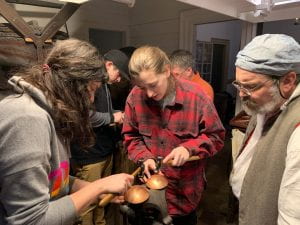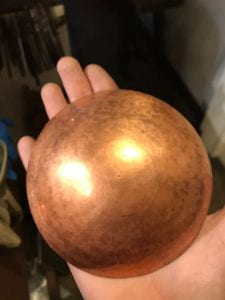Hammered Home: Silversmith Skills in Colonial Williamsburg
By Emily Whitted, WPAMC Class of 2020
The uneven ringing of eight hammers echoed loudly in the small silversmith’s shop on a Friday afternoon in Colonial Williamsburg. Under the watchful eye of Georg Cloyed, master silversmith, our Craftsmanship class immersed into the world of working silver and copper.
Seven of my classmates and myself, clutching our respective hammers, pounded away at circular copper billets with an end goal of raising them into small shallow bowls. They didn’t warn us beforehand about the level of noise; the sound quickly became almost deafening, and several of my classmates commented that the noise alone would have driven them out of mind had they taken up the silversmithing trade in the 18th century. The shop rang with our awkward rhythm, betraying our vast inexperience in metalsmithing of any sort, but as each of us grew slightly more comfortable with the execution of a hammer blow upon our copper works-in-progress, the sounds became a signifier of a successful swing. Every hammer blow needed to count; copper is a relatively malleable metal but grows harder the more its hammered, and the motion of hammering called forth long-neglected muscles in my arm that quickly grew sore. It seems like there’s no way to shape metal quietly, but sound also provides crucial sensory information to the smith, so I did my best to teach my ears to listen.
- We all started out with flat copper disks like the one pictured here, and would lightly trace concentric circles to use as a guide before hammering.
- I am beginning the process of shaping the bowl by hammering it into a hollow groove in a stump. Photo courtesy of Brooke Baerman, WPAMC Class of 2019.
The first step in the process of forming our bowls involved taking a flat wooden mallet and hammering the copper billet in concentric circles inside hollowed out portions of a large wooden stump. Moving the copper in slow, deliberate circles while hammering it against the curve of the wood slowly turned it into a shallow bowl shape.

My classmate Brooke and I hammer on the anvil while master silversmith George Cloyed looks on. Photo courtesy of Eliza West, WPAMC Class of 2019.
From there, we took our copper to the anvil, and with a planishing hammer we shaped it more deeply, working within the same concentric circles. I couldn’t help feeling reminded of feeding fabric into a sewing machine as I evenly turned my copper bowl under the hammer with my right hand, trying to hammer exactly the same motion every time with my left. Our final finishing technique involved using the flat end of the planishing hammer to smooth out the previous marks from shaping, but it required more precise hammering or else we’d accidentally dent the surface with the edge.

The bottom of my bowl after a third round of hammering, this time with the intention of carefully placing hammer marks in neat rows to smooth the surface as much as possible.
For some, there was an optional additional step of placing a small circular wedge exactly center inside the bowl and then hammering once sharply and straight down, which produced a small foot for the bowl. I was content with my bowl’s shape and balance and felt it looked better without a foot.

Master silversmith George Cloyed examines his work after hammering a foot into the base of a classmate’s bowl. Photo courtesy of Brooke Baerman, WPAMC Class of 2019.
I have only recently appreciated the fact that metal is the material for crucial tools in practically every trade, including other metals; our three-day trip to Williamsburg experiencing a variety of 18th-century trades really hammered that home. This was also true in the silversmith’s shop, as we worked on anvils, with metal hammers that needed to be kept as clean and smooth as possible in order to produce high-quality work. For me, this reliance on the evolution of working various types of metals in order to unlock the ability to work with others embodied the art and mystery of the silversmith. It also clarified for me why metalworking is always listed first in texts like R. Campbell’s 1747 book The London Tradesman when discussing other crafts; it truly is a foundational medium. I left the shop with my copper bowl in hand, sore muscles, and a newfound appreciation for the art of shaping silver.




Leave a Reply